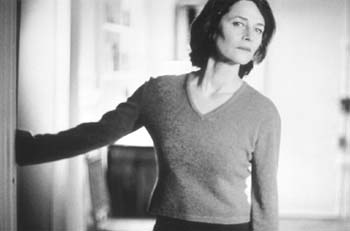![[Metroactive Movies]](/movies/gifs/movies468.gif)
[ Movies Index | Show Times | San Jose | Metroactive Central | Archives ]
 The Ruins of Rampling: With her mask of splendid arrogance, Charlotte Rampling commands the screen. Rampling Rose Plot plays second best to Charlotte Rampling in 'Under the Sand' A PICTURE of Charlotte Rampling taken by Helmut Newton in 1973 hangs in the British National Portrait Gallery. She's sitting nude on top of a table at the far end of a drawing room. Her fingers are tangled around a glass of white wine, and her bare legs are resting on a heavy chair. She's half-turned to the viewer, who has just entered the room through a door, reflected in an ornate mirror. Newton may have had nothing more complex in mind than posing the actress as if she were inviting a man for a quick one on the table. However, Rampling's mask of splendid arrogance, the brows and mane heavy for such a slender woman, the mouth downturned in tantalizing disapproval--all of this is far different from the come-hither look of a girly-picture model. She's more like an unfaithful wife discovered immediately after the act, angry that she's been interrupted. In Under the Sand, director François Ozon pays tribute to the lean, steely actress. She's now past 55 and in remarkable shape. Unfortunately, Ozon's film is a garden-variety mystery--not Alfred Hitchcock but a poorer episode of Alfred Hitchcock Presents. The seemingly happily married couple Marie (Rampling) and Jean Drillon (Bruno Cremer) arrive at their beach house. Monsieur Drillon looks ready for a vacation: he's very overweight and pale as a cardiac patient. On their first day on the beach, he vanishes without a trace. Likely he's been swallowed by the waves, but other possibilities crop up. Jarringly, Ozon cuts to a dinner party an untold amount of time later; Marie is still talking about her husband in the present tense. As we see, Jean is still alive to his wife; his ghost walks through the house. A friend of a friend, Vincent (Jacques Nolot), tries to date Marie out of her bereavement, but his efforts don't chase away the ghost. This sort of mystery can't sustain itself for long, although some incidents on the way to the open end stand out. A scene at the coroner's proves that mortally bad news ought to be delivered in French--a body in "putréfaction avancée" is more genteel a thing than it would be in English. Drillon's mother, Suzanne, a hostile old witch, gives the story some vinegar; but she's brought in late, only to confirm our suspicions that Marie is cracking. Ozon (Water Drops on Burning Rocks) pads the running time with the incidents of Marie's days: exercising at the gym and teaching her English students Virginia Woolf (roped in, apparently, because she died by water. It's obvious, however, that the real subject of the film is not the disappearance of Drillon but the appearance of Rampling: the way she pads across a room, how she shows contempt with those cruel hooded eyes, how she urges a lover around during sex. The ruins of Rampling, like many other historical ruins, are worth seeing but not worth going to see.
Under the Sand (Unrated; 90 min.), directed by François Ozon, written by Emmanuelle Bernheim, Marcia Romano, Marina de Van and Ozon, photographed by Antoine Héberlé and starring Charlotte Rampling and Bruno Cremer, opens Friday at the Camera 3 in San Jose. [ San Jose | Metroactive Central | Archives ]
|
From the May 31-June 6, 2001 issue of Metro, Silicon Valley's Weekly Newspaper.
Copyright © 2001 Metro Publishing Inc. Metroactive is affiliated with the Boulevards Network.
For more information about the San Jose/Silicon Valley area, visit sanjose.com.